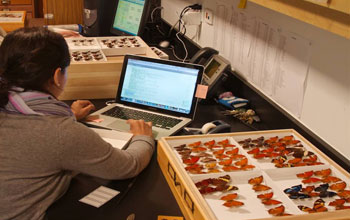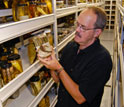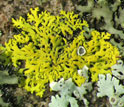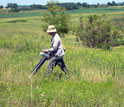News Release 11-136
NSF Awards Grants to Advance Digitization of Biological Collections
Funding will shed light on current "dark data," and integrate genetic, organismal, ecological information

Data-entry for the Lepidopteran (moths, butterflies) collection, Florida Museum of Natural History.
July 8, 2011
This material is available primarily for archival purposes. Telephone numbers or other contact information may be out of date; please see current contact information at media contacts.
Centuries of discovery document the diversity of life on Earth. Records of that biodiversity are, for the most part, in varied and distinct natural history collections, making assessing the information a difficult task.
Now, the National Science Foundation (NSF), through its Advancing Digitization of Biological Collections program, is responding to the need for greater accessibility of biological collections data by awarding four major grants that seek to create a national resource of digital data documenting existing biological collections.
Biological diversity is critical to the future of our planet, say researchers. Incomplete information on species, their distributions and environmental and biological changes over time make it difficult, however, to assess the status of and changes in biodiversity.
Much of the relevant information exists in the nation's research collections, but the majority isn't integrated and isn't readily available online. It's "dark data"--inaccessible to most biologists, policy-makers and the general public.
"Biological research collections are valuable national resources that document hundreds of years of environmental change as reflected in changes in biodiversity, and provide baseline data for studies of the effects of climate and land use change, and invasive species, on organisms," says Joann Roskoski, acting director of NSF's Directorate for Biological Sciences.
"This program will markedly increase the accessibility of valuable information residing as 'dark data' in collections to researchers, educators and the public, and will stimulate new research across many fields of science and engineering."
One award will establish a central National Resource for Digitization of Biological Collections, and three large collaborative awards will allow for the development of Thematic Collections Networks (TCNs) to digitize data from biological research collections, and make the data available to scientists and the public.
The program is expected to result in more efficient and innovative ways to provide access to information in biological research collections, and to speed up the process of integrating diverse information on the genetic, ecological, organismal and molecular biology of specimens in collections.
Standardized digital photos of specimens will be linked with DNA sequences, pathogens found on the specimens, environmental variables at the collecting localities, and electron micrographs, for example.
Training for future researchers on collections techniques, informatics technology and data integration is part of the efforts.
The awards provide graduate and undergraduate training opportunities, and outreach to K-12 educators, students and non-scientists.
Each of the three TCNs focuses on "grand challenge" (major scientific) questions in biodiversity, and offers multiple research opportunities as data become widely available. The TCN awards include 92 institutions in 45 states.
Title: A Collections Digitization Framework for the 21st Century
PI (Principal Investigator): Lawrence Page, University of Florida
Summary: The Integrated Digitized Biocollections (iDigBio) will serve as a permanent national resource to integrate data from biological research collections around the United States. It will work actively with the Thematic Collections Networks to establish and disseminate best practices, coordinate outreach and training activities, assess gaps in information and new technologies for specimen digitization, and ensure that information is accessible to the public and to biological researchers via the Internet.
The award will fund a new undergraduate course on bioinformatics and fellowships for graduate students and sabbatical programs for junior faculty, especially women and individuals from underrepresented groups in the sciences. A web site and museum exhibits will serve as portals for documentation of activities and innovations, as well as a way to communicate with museum visitors and groups interested in digitized natural history data.
Title: InvertNet--An Integrative Platform for Research on Environmental Change, Species Discovery and Identification
PI (Principal Investigator): Christopher Dietrich, University of Illinois, Urbana-Champaign
Collaborators: Gregory Zolnerowich, Kansas State University; Anthony Cognato, Michigan State University; Paul Tinerella, University of Minnesota, Twin Cities; Paul Johnson, South Dakota State University; Daniel Young, University of Wisconsin, Madison; Johannes Klompen, Ohio State University; Jennifer Zaspel, University of Wisconsin, Oshkosh; Andrew Short, University of Kansas; Jeffrey Holland, Purdue University; John Rawlins, Carnegie Institute; Robert Sites, University of Missouri, Columbia; Gregory Courtney, Iowa State University; David Rider, North Dakota State University, Fargo
Summary: Arthropods (insects, spiders, crabs) are the most diverse and abundant group of macro-organisms in biological collections, but are underrepresented in databases accessible online or elsewhere. This project will centralize access to and synthesize information from 160 years of North American arthropod collections. It will use innovative technology, including optical 3D imaging and reconstruction, to support scientific inquiry on the effects of land use change on biodiversity, and basic research on species discovery and identification.
The award will provide IT infrastructure for collection digitization, digitally-assisted curation, and collection management; availability of specimen-level data for scientific inquiry on human impacts on biodiversity; and greater use of and appreciation for scientific collections by non-scientists through access to specimen images and related data.
Title: Plants, Herbivores and Parasitoids: A Model System for the Study of Tri-Trophic Associations
PI (Principal Investigator): Randall T. Schuh, American Museum of Natural History
Collaborators: Richard Rabeler, University of Michigan, Ann Arbor; Charles Bartlett, University of Delaware; Robert Naczi, New York Botanical Garden; Robert Magill, Missouri Botanical Garden; Christiane Weirauch, University of California, Riverside; Benjamin Normark, University of Massachusetts, Amherst
Summary: All the nearly 20,000 plant species in North America are attacked by insect pests, including those in the group Hemiptera (known as the "true bugs"), which are in turn attacked by parasitoid insects in the Hymenoptera (sawflies, wasps, ants), widely used for biological control of agricultural pests. This project will unify some eight million records in 34 collections to answer how the distributions and phenologies of the plants, pests and parasitoids relate to each other, in a Tri-Trophic Databasing and imaging project--the TTD.
Data from this approach will benefit basic scientific questions and practical applications in the agricultural sciences, conservation biology, ecosystem studies and climate change and biogeography research.
Technological tools and methods will be introduced to graduate students, affiliated universities, and grant-sponsored students from other institutions through a short course. A data-mining and species-distribution modeling symposium at the University of California-Riverside will foster interactions between systematics and ecological researchers, and explore the TTD as a platform for instruction and inquiry.
Title: North American Lichens and Bryophytes: Sensitive Indicators of Environmental Quality and Change
PI (Principal Investigator): Corinna Gries, University of Wisconsin, Madison
Collaborators: Andrew Miller, University of Illinois at Urbana-Champaign; Edward Schilling, University of Tennessee Knoxville; Meredith Blackwell, Louisiana State University & Agricultural and Mechanical College; Donald Pfister, Harvard University; Francois Lutzoni, Duke University; Robert Luecking, Field Museum of Natural History; Bruce Allen, Missouri Botanical Garden; Timothy James, University of Michigan, Ann Arbor; Larry St.Clair, Brigham Young University; Stefanie Ickert-Bond, University of Alaska, Fairbanks; William Buck, New York Botanical Garden; John Freudenstein, Ohio State University; Tatyana Livschultz, Academy of Natural Sciences Philadelphia; David Giblin, University of Washington; Alan Fryday, Michigan State University; Brent Mishler, University of California, Berkeley
Summary: Lichens and bryophytes (mosses and their relatives) are sensitive indicators of environmental change, and are dominant organisms in arctic-alpine and desert habitats, where the effects of climate change are well-documented.
This project will image about 2.3 million North American lichen and bryophyte specimens from more than 60 collections to address questions of how species distributions change after major environmental events, both in the past and projected into the future.
Large-scale distribution mapping will help identify regions where such changes are likely, fostering programs designed to protect these organisms. Awardees plan to build and enhance a national volunteer community, and provide online seminars, extensive online training materials, and local workshops and field trips.
-NSF-
-
Scientist Larry Page amid the fish collection at the Florida Museum of Natural History.
Credit and Larger Version -
Lichens on tree bark in Indiana; their distribution is strongly affected by environmental change.
Credit and Larger Version -
Entomologist Chris Dietrich 'vacuums' for insects in tallgrass prairie among corn, soybean fields.
Credit and Larger Version -
A once-widespread flightless leafhopper found in prairies is now listed as endangered in Illinois.
Credit and Larger Version -
To help advance biological collections, a researcher collects insects in the field.
Credit and Larger Version
Media Contacts
Cheryl Dybas, NSF, (703) 292-7734, email: cdybas@nsf.gov
The U.S. National Science Foundation propels the nation forward by advancing fundamental research in all fields of science and engineering. NSF supports research and people by providing facilities, instruments and funding to support their ingenuity and sustain the U.S. as a global leader in research and innovation. With a fiscal year 2023 budget of $9.5 billion, NSF funds reach all 50 states through grants to nearly 2,000 colleges, universities and institutions. Each year, NSF receives more than 40,000 competitive proposals and makes about 11,000 new awards. Those awards include support for cooperative research with industry, Arctic and Antarctic research and operations, and U.S. participation in international scientific efforts.
Connect with us online
NSF website: nsf.gov
NSF News: nsf.gov/news
For News Media: nsf.gov/news/newsroom
Statistics: nsf.gov/statistics/
Awards database: nsf.gov/awardsearch/
Follow us on social
Twitter: twitter.com/NSF
Facebook: facebook.com/US.NSF
Instagram: instagram.com/nsfgov





